We were up and on the zodiac at 6am. No-one was sure why. Sarah had said we needed to start at that time since some people might have flights to get to early that morning. After a brief show of hands, no-one did, but we still had to get up for stupid o'clock for no valid reason. It wasn't worth it. Aside from the hundreds of pelicans we saw en route, Black Turtle Cove was just a cove which contained around three turtles, a sea snake and a black-tipped reef shark. We had to kill the engines, and then the zodiac drivers paddled with oars in order not to disturb the huge masses of wildlife we didn't see. It was disappointing, but it didn't piss us off as much as when we returned to the boat. We were heading to breakfast when Sarah told us we had a call from Yoconda at the agency. We went to take it, and she told us that she hadn't managed to secure the spaces on the Guantanamera for us, but there'd be a taxi waiting for us to take us to the highlands when we returned to land. When we got back to the dining room, almost all of the food was gone. There was a sparce scattering of fruit, but there were no eggs and no bacon. The rest of the passengers had cleared the lot. Not to worry, I thought. Surely the chef can crack a couple more eggs for us? I asked Briandy - no. No more food. This was crazy. I went to Sarah to see if she could help us out, and she said that she would ask the chef. Ultimately, both the guide and the staff told us the other passengers had eaten our food, it wasn't their problem, and we weren't getting anything else. It ended the trip on a bitter note, especially given the previous evening's meal and the fact that Sarah had spent five minutes explaining that the "normal" tip for a trip was 15-20% of whatever you paid at the agency, as well as telling us that there would be comment cards in case we had any complaints or suggestions. As we expected, the comment cards didn't materialise for any of the passengers. Still, I guess that's what TripAdvisor is for...

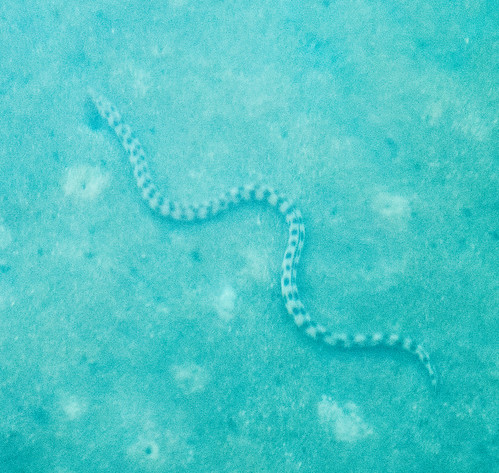
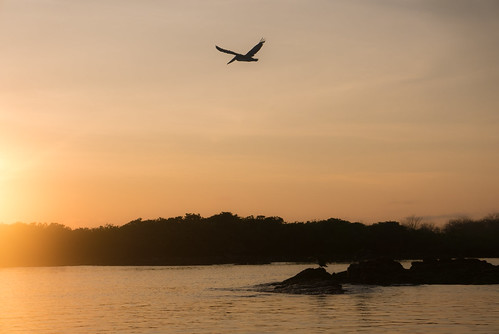

We were dropped off at the airport, and after some confusion about which bus to get, we managed to get a free one to the ferry. As promised, there was a chap waiting for us at the other side with our names (well, a close approximation) on a sign. His name was Andre, and he spoke very good English which allowed me to practice a bit of Spanish on the ride to Los Gemelos - the twins. These are two craters which have formed in the highlands of Santa Cruz. They're now covered in trees and bushes in the base, but it's still impressive to see their depth.
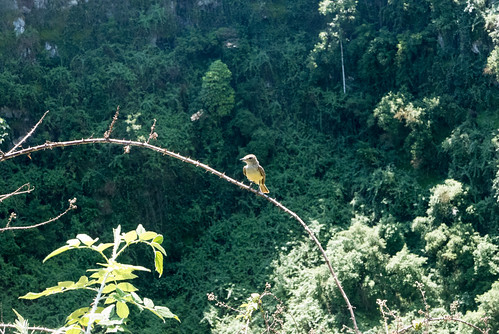
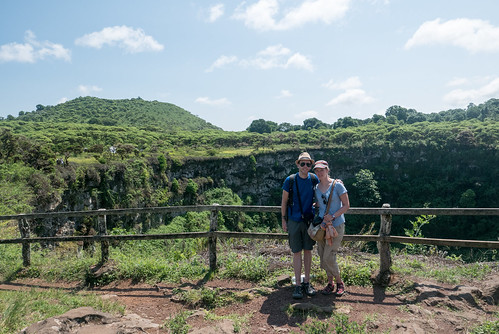
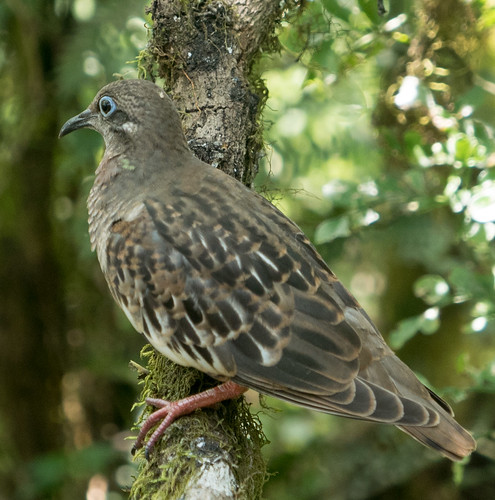
Next up were more lava tunnels. These ones were actually lit and had an exit, so were easier to navigate. It didn't stop Gilly managing to smash her second pair of sunglasses on the roof of the tunnel, although they somehow survived enough for us to try supergluing them at a later date. Our final stop was a giant tortoise reserve. We were able to walk around and see the tortoises in the wild, rather than in a zoo or breeding centre, and they were absolutely huge. The reserve itself was pretty big, and had lots of swampy areas for them to roam and go about their business. This included mating, which didn't look particularly comfortable for either party. Given they can weigh up to 300kg, it was certainly a test of the strength of their shells. We got to try being tortoises ourselves a bit later on. It wasn't as comfortable as we make it look.
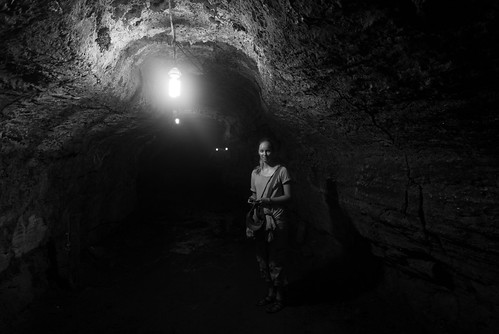
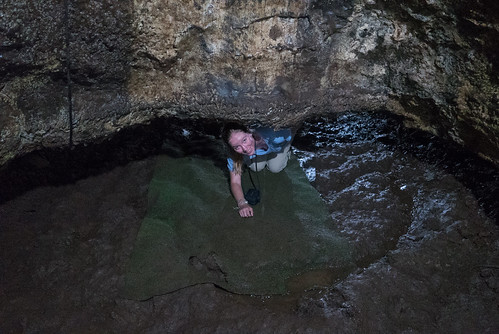
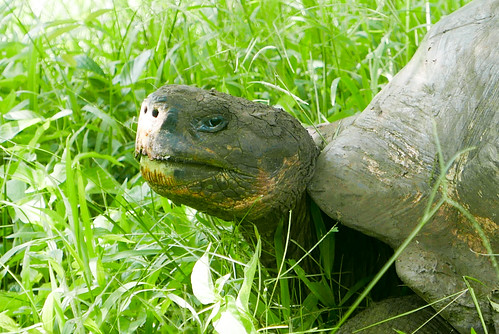
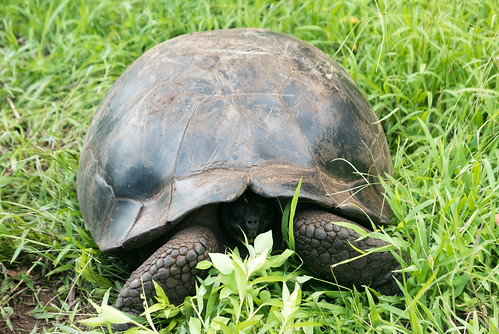
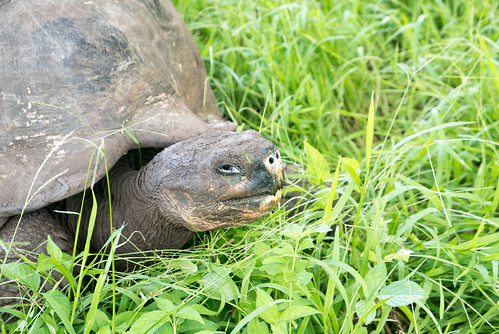

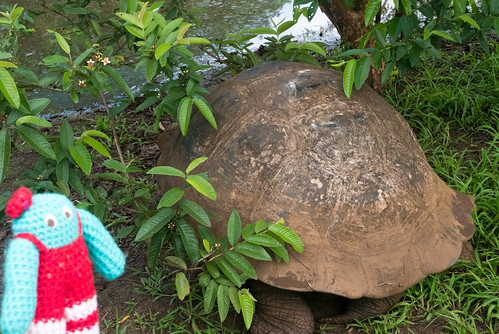

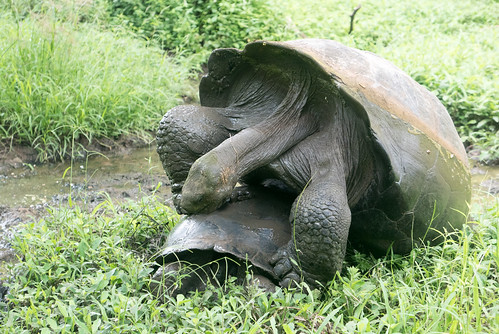
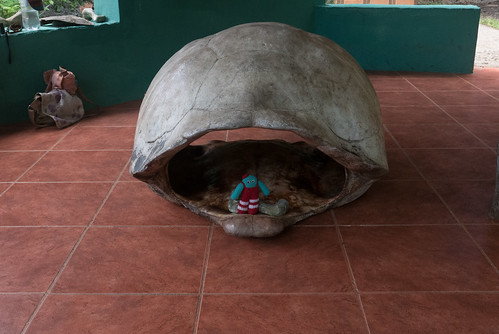


Back in town, we needed to decide on a plan of action. First though, food was the priority. We paid through the nose for an admittedly great pizza at Galapagos Deli (cooked on lava rock, no less, although I'm not entirely sure what that added to the experience), and made use of the Wi-Fi to do very little since the connection on the island was shocking throughout. We headed back to Yoconda's place to drop off the snorkel equipment, only to find that they couldn't locate my driving licence which I'd left as a deposit. We decided to hold onto the equipment. Then it was over to Mockingbird to see if we could speak to someone without ADHD. It turns out that Staling was on the desk - the guy who Sergio was trying to call on the day we bought the Yolita tickets. He told us that the Guantanamera was still available. Hold on, we said, Yoconda told us there were no spaces left! No, there were, but Staling had bought them to resell. Now he wanted to charge us an extra $100 per person for them compared to the price Sergio had given us. That clearly wasn't going to happen. Back at Yoconda's, she found my licence and told us that she wanted to give us the tickets but Staling wouldn't sell them to her. Over at Mockingbird, Staling eventually relented and gave us the tickets at the original price, but not before Yoconda had called him three times and messaged him on WhatsApp, accusing him of stealing her customers. It was hilarious - the two agencies are literally opposite each other on the same road. I was expecting it to climax in some sort of Wild West duel.
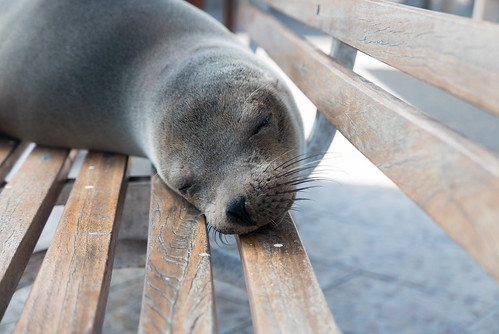
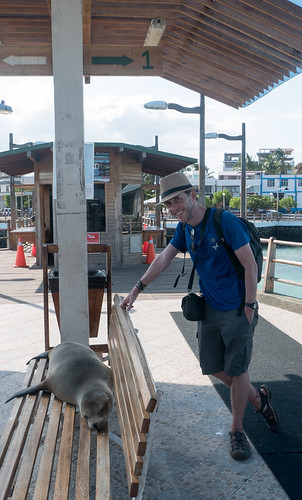
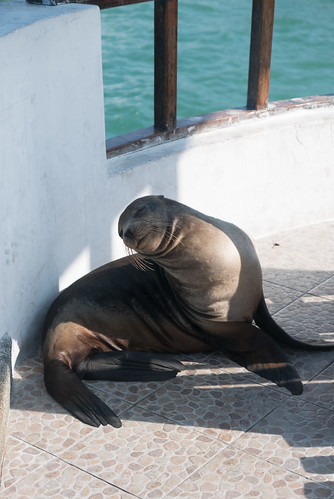
Whilst in the agency, we spoke to another couple who were going to be joining us - Steve and Sophie. Steve was a Kiwi, whilst Sophie was from Oz, but coincidentally they'd both lived in Bristol for a fair amount of time so we immediately hit it off. After a walk around town whilst waiting for the boat followed by a cheeky beer, we were back for our pick-up to the airport. Staling tried to tell us that we'd have to pay for a taxi because "there was some issue with the transport, and the guy isn't coming now", but the four of us made it clear that this wasn't our issue, and eventually a ride materialised to take us to the boarding point (after collecting a couple of hitch-hikers and somehow getting through a security checkpoint - only five people can be in a car at any time). We arrived on board the Guantanamera in time for a safety briefing and dinner, and were introduced to the crew and our guide Johan who immediately made us feel much more confident in his abilities than Sarah did. The room was probably the worst thing about the boat since it smelled of damp and was a little more cramped than our previous room, but it was still fine - we wouldn't be spending a huge amount of time in it, after all. The food was buffet-style but was very good, and the rest of the passengers looked like they'd be great fun to spend the next week with; aside from Steve and Sophie, there were three more Aussies (Megan, Craig and Jack), three ladies from Hong Kong (Jessica, Linda and Helen), two Swiss guys (Paawo and Jonathan), a German girl (Sylvia) as well as a couple of Canadians (Brea and Lee) and a California girl (Anna) who would only be staying for half of the journey. After the briefing for the next day, we all retired to bed - it had been a pretty exhausting day.
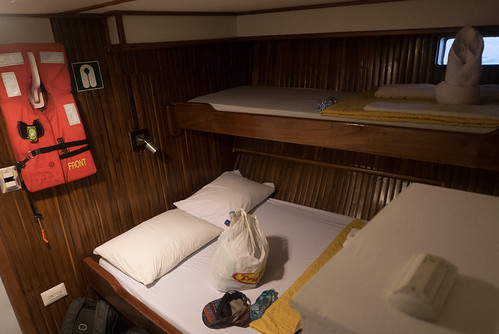
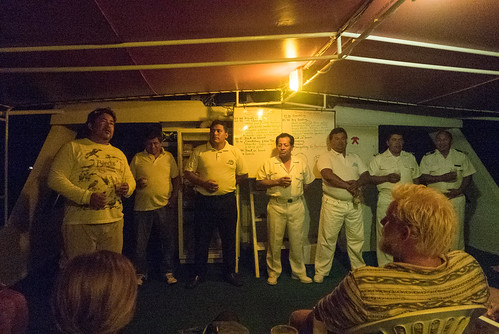
It was definitely the most choppy night we'd experienced to date. However, while the bed was nowhere near as comfortable as the Yolita's, it was still good enough for us to sleep pretty well. The breakfast was a similar buffet-style too, but with more food (hurrah!) and we were raring to get going after eating. We'd arrived at Genovesa, a birdwatcher's dream. I won't claim to be any sort of twitcher, but I was very hopeful to see a frigatebird - the kind with the huge red membrane that puffs out like a balloon in order to attract mates. Johan told us that it was only a possibility, since we were in the last couple of weeks of the mating season. So, it was a great surprise to arrive in Darwin Bay on the island and find the beach and surrounding trees covered in them

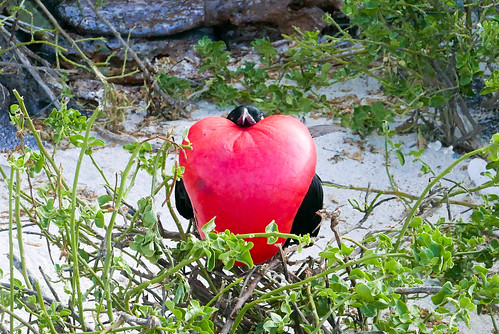


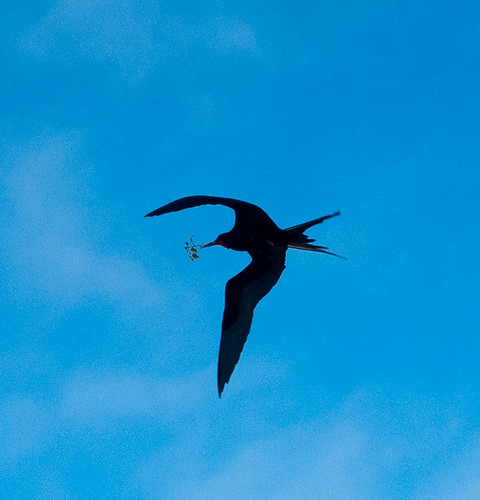
Frigatebirds are known as the pirates of the skies (see also: frigate ships), because they steal 70% of the food they eat from other birds. They don't have the oily coating that other sea birds have, so if they tried to dive for fish they'd end up drowning. It isn't just food either, as we saw one snatch twigs out of the beak of a booby in mid-air. They are magnificent beasts, and when fully puffed up they shake their chest to try and attract a mate. The other attraction on Genovesa is the red-footed booby, which can only be found in a couple of places throughout Galapagos. What amazed me is how tame the wildlife is on the island. No predators have been introduced, so none of the birds have ever learned to be scared of humans. As such, you can get pretty much in their face (well, two metres away) without them even blinking. Other birds we saw included the Nazca booby which looks like a gull, Darwin finches, swallow-tailed gulls, doves and lava herons. There was also a red-footed booby which had white feathers; evolution is slowly replacing the recessive gene which causes this colouration with the more common brown feather gene.
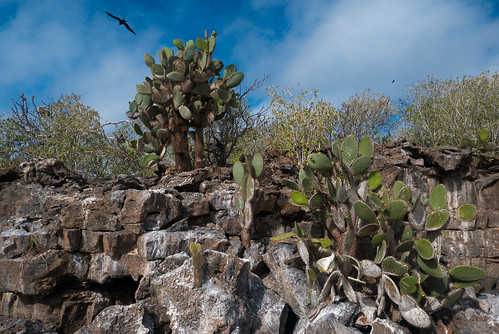

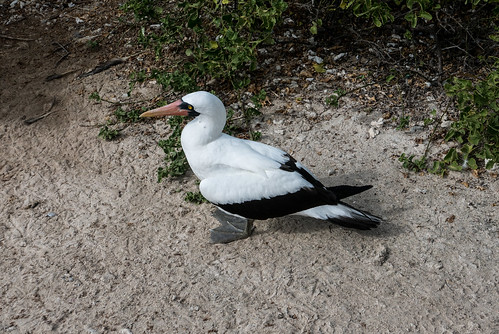
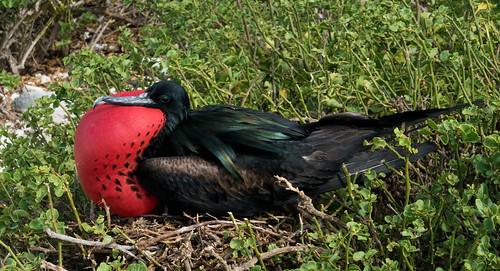
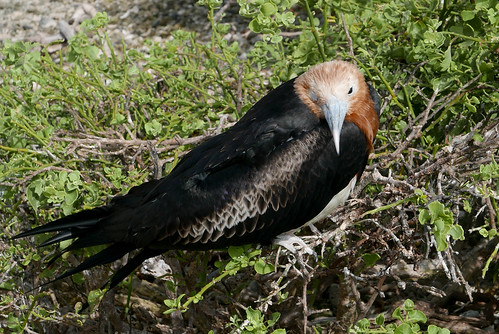
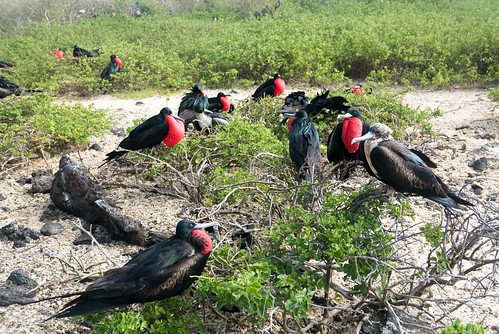



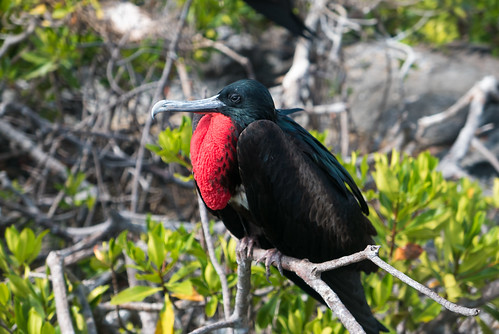
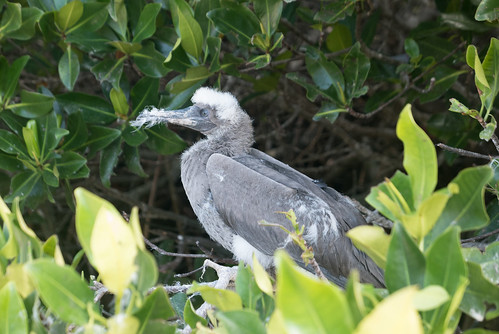

After finishing our walk around the island, we tried some snorkelling near the beach to test our equipment, and after a short break we headed out on zodiacs to Darwin Bay to do some proper snorkelling with the objective of seeing hammerhead sharks. These were the animals I most wanted to see during our time here, but the waters were rough and the visibility pretty awful so our chances were slim. However, after hitting the water, another boat told us that they'd seen a couple of sharks not far away. Fifteen minutes later, I got a glimpse of them. In those brief ten seconds, it seemed like their tails looked quite similar to those of thresher sharks, and the mouths behind their odd-shaped heads were zig-zag lines. Thinking about it now, it seems almost like a dream - with the naff visibility and minimal time they hung around, I kept questioning what I actually saw. I tried to get the attention of the group, but by the time they got over to me the sharks had disappeared. I hoped we'd get to see more again before we left. We took a second snorkel over to the opposite rocks where the visibility was even worse, but we did see three fur sealions sat on rocks and a pregnant sealion who joined us briefly in the water.
Like all the meals we were going to get on the Guantanamera, lunch was a buffet and was excellent: a ceviche-style mix, pasta and pesto, rice, fried banana crisps, popcorn and watermelon. Three meals in, and we both felt that the food was already better than the Yolita. We had a bit of downtime to let it digest, and then another optional snorkel which we decided to take advantage of just in case we happened to see something spectacular. We didn't - the visibility was awful.
The Prince Philip Steps was our final stop for the day, named after the privileged racist who visited here briefly some years ago. The bird life was abundant, and we got to see Nazca boobies not only incubating eggs, but also nursing newly hatched chicks. They lay two eggs, and the biggest of the offspring will invariably kill the other (often with the help of the mother) in order to get the most food, in some Game of Thrones-style fratricide. We also saw male Nazca boobies offering presents to females as part of the mating ritual, usually twigs or other nesting material. The females we saw weren't particularly happy with the gifts, perhaps holding out for some bling or maybe a bottle of Coco Petrel. Johan got pretty excited when he spotted some black birds on branches in the distance. He had managed to drop his phone in the water, so enlisted Sylvia with her crazy zoom lens to take photos; they were smooth-billed anies, a species that had been introduced to the Galapagos some years ago by humans and which rangers were trying to eliminate. They fought for food amongst the endemic species, as well as having parasites which played havoc with the ecosystem. It hadn't been known that they were on Genovesa, so spotting three of them here was pretty significant and Johan needed to tell the rangers on Isabela when we arrived there in a couple of days. Other avians spotted on the walk were the short-eared owl which, unlike our owls, are active in the day, the mockingbird, the Galapagos dove, and Johan's favourite bird: the red-billed tropicbird.
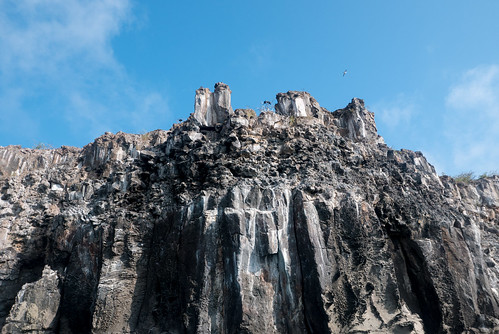
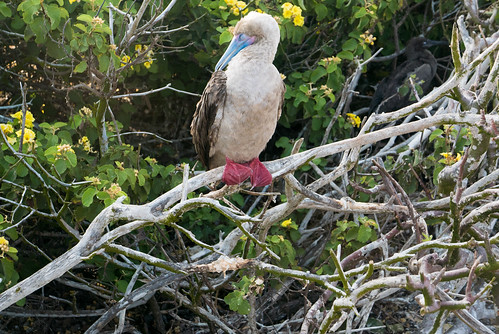


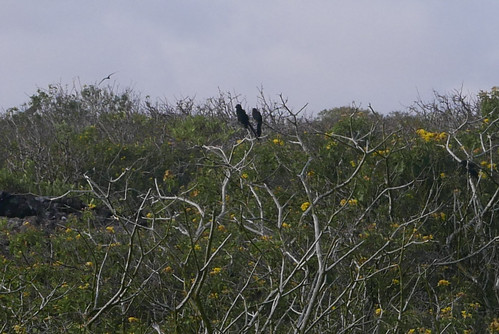
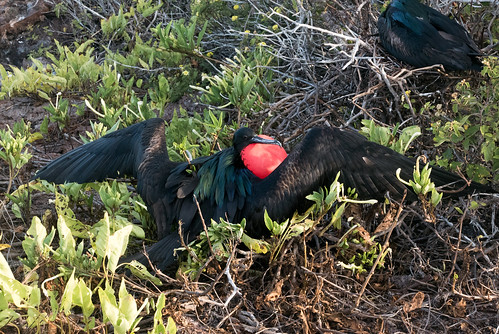

No comments:
Post a Comment